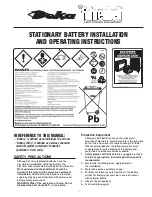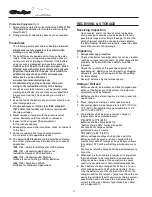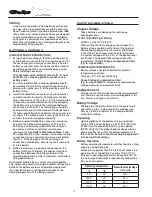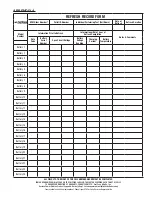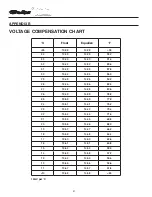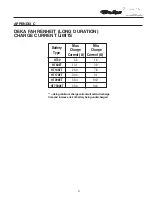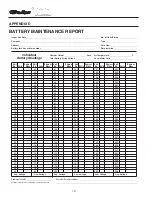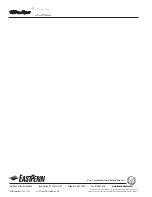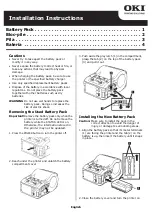
5
®
Battery Operation cont.
The battery string operating temperature should not
exceed 140˚F (60˚°C).
If operating temperatures
are expected to be in excess of 140°F (60°C),
contact East Penn for recommendations.
Discharging at temperatures less than 77˚F (25˚C)
will reduce the capacity of the battery.
If operating
temperatures are expected to be less than 50°F
(10°C), contact East Penn for recommendations.
The battery string must be located in a manner that
the individual batteries do not vary by more than 5˚F
(2.8˚C) between the lowest and highest individual
battery temperatures.
Rectifier Ripple Voltage
FREQUENCY
Ripple that has a frequency greater than 667Hz
(duration less than 1.5ms) is acceptable, unless it is
causing additional battery heating.
Ripple that has a frequency less than 667Hz (duration
greater than1.5ms), must meet the following voltage
specification to be acceptable.
VOLTAGE SPECIFICATION
Ripple voltage shall be less than 0.5% peak to peak of
the manufacturer’s recommended battery string volt-
age.
Failure to comply can void the warranty.
RECORD KEEPING
Voltages, Temperatures & Ohmic
READINGS
Record keeping is an important part of stationary
battery maintenance and warranty coverage. This
information will help in establishing a life history of
the battery string and inform the user if and when
corrective action needs to be taken.
Consult Battery
Maintenance Report. (Pg. 10 – Appendix D).
While it is acceptable to operate at temperatures less
than 77°F (25°C), it will require longer charging time to
become fully recharged. Also, the capacity will be less
at operating temperatures below 77°F (25°C).
After installation and when the battery string has
been on float charge for one week, the following data
should be recorded:
1. Battery string voltage at battery terminals while bat-
tery is on float charge.
2. Charger voltage at charger panel meter.
3. Individual battery float voltages.
4. Ambient temperatures within area of battery string.
READINGS cont.
5. Terminal connections should be checked to verify
that the installer did torque all connections properly
to 100 in lb +/- 5. Micro-ohm readings should be
taken across every connection. Refer to meter
manufacturer’s instructions for proper placement of
probes. If any reading differs by more than
20%
from
its initial installation value, re-torque the connection
to 100 in lb +/- 5.
If reading remains high, clean
contact surfaces according to Step 1 under Battery
Assembly.
Failure to maintain proper records including
information as detailed above may result in
voiding any applicable warranty.
ACCEPTANCE TESTING
Each battery should be at 100% State of Charge prior
to performing an acceptance test on the battery sys-
tem. To ensure the batteries are fully charged the fol-
lowing charge schedule should be followed.
Batteries should be charged at the equalization rate of
14.40 volts per battery for 24 hours. Temperature com-
pensated charging parameters shall be applied as
detailed in
“Voltage Compensation Chart”
in Appendix
B of this manual.
To ensure the batteries are fully charged within 24hrs;
the charger used for this charge must have the current
equal to the maximum charge current for the given
battery type (model), as called out in Appendix C of
this manual.
If these requirements cannot be met, contact East
Penn Reserve Power’s Product Support group for al-
ternate instructions.
Upon completion, the charge voltage should be low-
ered to the float voltage of 13.50 volts per battery
for a minimum period of 72 hours. Reference: IEEE
1188-2005 Section 7.2 for additional acceptance test
requirements.
Upon completion of the above charge, the desired
acceptance test can be performed.
NOTE:
There shall be no discharges of any duration
between the start of the equalization and the comple-
tion of the float period. If a discharge does occur, the
charging regime detailed above shall be repeated.
Upon completion of the acceptance test, the battery
system should be placed on float charge at 13.50 volts
per battery to restore the battery to its’ rated capacity.
Batteries should not require an equalization charge
once they have passed their initial acceptance test.
Consult with East Penn Reserve Power’s Product
Support group before performing additional equalizing
charges on batteries that have successfully passed
their initial acceptance test.

